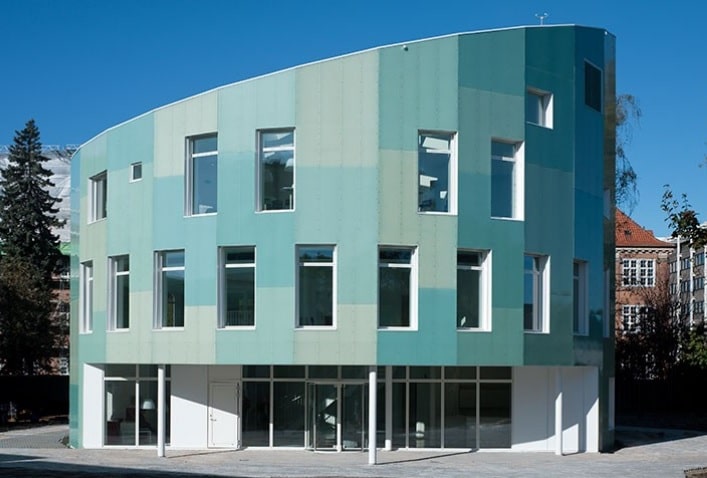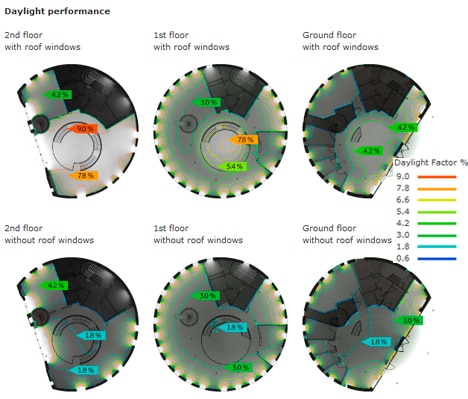-
Phone Number
-
Email Address
At the time we already talked about the characteristics of the LEED certification in sustainable buildings ( Here ). In this article we will discuss some of the most significant criteria on the design and the technical characteristics of the Green building Lighthouse located at the University of Copenhagen , which help make it one of the most representative sustainable buildings in Europe, being the first public building in Denmark to achieve the Leed Gold certified. It is a building that it practically does not generate CO2 emissions , intended for offices as well as for students of the Copenhagen Faculty of Sciences.

This is a sustainable and energetically efficient designed to achieve a correct balance between indoor climate, architecture and new technologies to minimize CO2 emissions as much as possible and Eliminate your environmental impact. The fundamental criterion that applied for its design was based on achieving a maximum use of natural light, based on the application of basic concepts of sustainability, to achieve a design optimum that would substantially reduce their demands energetic.
Based on this premise, it was decided to opt for a circular shape with windows that were exactly located, based on a simulation carried out, to get the maximum gain of light and Allow adequate ventilation inside the himself , having carried out an important study to ensure that this objective was achieved. For achieve the maximum capture of natural light in the building It has windows not only on its cylindrical façade but also on the ceiling.

Features a design that allows behavior similar to if it were a solar lamp that is capable of capturing the light in any situation and at any time, said use allows the building to require a minimum of artificial light, which affects the consumption of electricity.
The windows of the same present frames with a high insulation and glass providing good insulation thermal system that reduces heat losses and simultaneously allows the gain of sun to the building. They present as systems sun protection shutters with venetian blinds in front of them, which adjust automatically and In this mode, adequate light recovery is achieved for reflect it towards the center of the building and thus «distribute» and send it to all the rooms inside.
Its design allows adequate night cooling in the hot summer nights as the air warms from your interior that is lighter, rises and ascends to the roof windows, generating a continuous renovation that helps to achieve adequate conditions.
One of its notable characteristics is that it manage to reach internal conditions of temperature and healthy humidity, in a way that allows it to maintain a comfortable temperature throughout the year . Natural ventilation has been designed so that the user himself building breathes and allows the opening and closing of windows tops, which are activated automatically to allow the natural circulation of air through the central core of circular shape, producing a chimney effect that helps to its proper ventilation. It is possible with this design to create some ideal comfort conditions avoiding the need to use air conditioning equipment.
The following video explains graphically and clearly its energetic behavior and what are some of the its most relevant design features:
The construction elements of the envelope are characterized for presenting a high thermal insulation both in the façades as well as on the roof, thus reducing the heating demands and causing the building to lose the least amount of energy possible during the hours nocturnal in which it does not receive solar radiation.
The building was designed with a cylindrical shape and a flat cut in its cover, generating an oriented skirt to the south in order to get the proper orientation of the solar collectors that have been placed in covered, so that it has been completely covered with thermal and photovoltaic solar panels to generate both sanitary hot water, as well as to be able to illuminate the building and supply energy for heating. Besides It also has technological systems that help to improve and manage the energy efficiency of the building as heat recuperators, solar heaters, LED lighting and geothermal.

Regarding the materials used for its construction fundamentally prefabricated elements and panels predominate steel and concrete, although the facade uses a material called “Swissfiber” which is composed of glass recycled and a polymer . In this way, a light façade that shelters and protects the building. It is treated by both made of a prefabricated material that is easy to assemble and has allowed its rapid execution.
Regarding facilities, it presents a solar heat pump with geothermal energy which comes into operation if there is no stored solar heat. When solar energy is not enough to keep the interior comfort, district heating is used, which allows the operation of the heat pump.
The renewable energies cover most of the energy demand of the building , so that achieve savings that reach 80% on a traditional type building. The electricity needed for the air conditioning, lighting and ventilation come from the roof solar collectors, with an area of 76 m2 of photovoltaic panels, so that 35% of the solar energy comes from solar collectors and heat solar stored in the ground and 65% comes from the district heating and geothermal heat pump.
These facilities have been designed to achieve optimal and efficient use of radiation solar , so that in summer take advantage of the excess sunlight that accumulates on a platform located on the ground floor to be able to reuse it in winter, and also it is also used to provide cooling indoors in summer.
For more information on LEED certification we can Access this article... HERE .
……………………………….
Article prepared by José Luis Morote Salmeron (Technical Architect – Energy Manager - Google profile plus) Access to your website HERE, in collaboration with Home Repair Care .